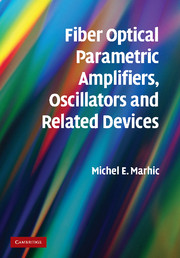Book contents
- Frontmatter
- Contents
- Acknowledgments
- 1 Introduction
- 2 Properties of single-mode optical fibers
- 3 Scalar OPA theory
- 4 Vector OPA theory
- 5 The optical gain spectrum
- 6 The nonlinear Schrödinger equation
- 7 Pulsed-pump OPAs
- 8 OPO theory
- 9 Quantum noise figure of fiber OPAs
- 10 Pump requirements
- 11 Performance results
- 12 Potential applications of fiber OPAs and OPOs
- 13 Nonlinear crosstalk in fiber OPAs
- 14 Distributed parametric amplification
- 15 Prospects for future developments
- Appendices
- Index
- References
3 - Scalar OPA theory
Published online by Cambridge University Press: 23 March 2010
- Frontmatter
- Contents
- Acknowledgments
- 1 Introduction
- 2 Properties of single-mode optical fibers
- 3 Scalar OPA theory
- 4 Vector OPA theory
- 5 The optical gain spectrum
- 6 The nonlinear Schrödinger equation
- 7 Pulsed-pump OPAs
- 8 OPO theory
- 9 Quantum noise figure of fiber OPAs
- 10 Pump requirements
- 11 Performance results
- 12 Potential applications of fiber OPAs and OPOs
- 13 Nonlinear crosstalk in fiber OPAs
- 14 Distributed parametric amplification
- 15 Prospects for future developments
- Appendices
- Index
- References
Summary
Introduction
In this chapter we introduce the basic types of fiber optical parametric amplifier (OPA) and simple models to study their characteristics. We will confine ourselves to situations in which all the waves are launched into the fiber with the same linear state of polarization (SOP) and remain in that state along the entire fiber. This allows us to consider a single component of the electric field and hence to write scalar equations for it. We first set up the basic OPA equations starting from Maxwell's equations for the case of nonlinear polarization. In the process we derive an expression for the fiber nonlinearity coefficient γ in terms of the waveguide properties and those of the interacting modes. We then proceed with the solution of the OPA equations in a variety of situations for which exact solutions are known. The solutions in the absence of loss and pump depletion are relatively simple, being expressible in terms of exponentials, or alternatively in terms of sinh and cosh functions. They are used extensively in practice as a first approximation to calculating the gain spectra of various fiber OPAs. Solutions in other regimes are more complicated; some involve Bessel functions, others involve Jacobian elliptic functions, etc. While it is more difficult to grasp their properties, they can be useful computational tools for obtaining accurate results when the exponential solutions are not applicable.
- Type
- Chapter
- Information
- Publisher: Cambridge University PressPrint publication year: 2007
References
- 2
- Cited by



